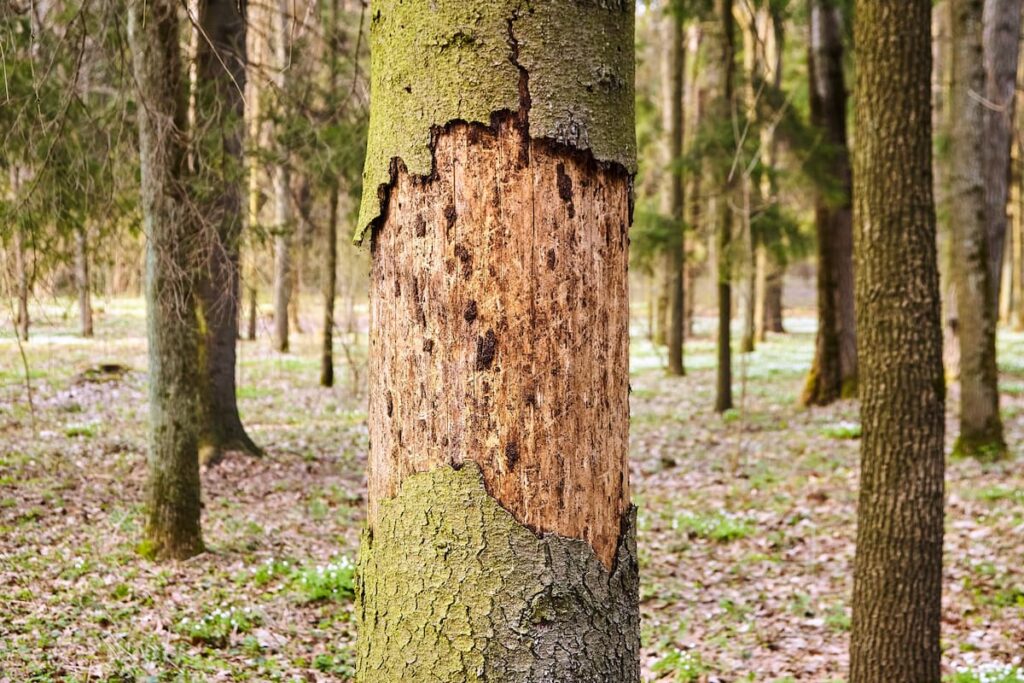Dying Tree or Sick Tree Treatment in Texas. Trees are a vital part of the ecosystem in Texas and provide many benefits to the environment and community. However, trees can become sick or die for various reasons, including pests, diseases, and environmental factors. It is important to identify and address sick or dying trees in a timely manner to prevent further damage to the tree and surrounding area.
Common Dying Tree or Sick Tree Symptoms
There are several signs that a tree may be sick or dying in Texas. Some common symptoms include:
- Brittle or cracking branches: If a tree’s branches are brittle or cracking, it could be a sign that the tree is not getting enough water or nutrients.
- Leaning or tilting: If a tree is leaning or tilting significantly, it could be a sign of root damage or instability.
- Dead branches: If a tree has dead branches, it could be a sign of a deeper issue such as a pest infestation or disease.
- Discolored or wilted leaves: If a tree’s leaves are discolored or wilted, it could be a sign that the tree is not getting enough water or nutrients.
- Bark abnormalities: If a tree has abnormal bumps or bulges on its bark, it could be a sign of a pest infestation or disease.
Causes of Dying Trees or Sick Trees in Texas
There are several causes of sick or dying trees in Texas. Some common causes include:
- Pest infestations: Trees in Texas can be affected by various pests, including insects and fungi. Pest infestations can weaken a tree and make it more susceptible to other problems.
- Diseases: Trees can also be affected by various diseases, such as fungal infections and viruses. These diseases can weaken a tree and make it more prone to other issues.
- Environmental factors: Environmental factors such as drought, extreme weather events, and soil conditions can also contribute to a tree’s decline.
If you suspect that a tree on your texas property is sick or dying, it is important to consult with a certified arborist. An arborist is a professional who is trained in the care and maintenance of trees. An arborist can assess the tree and determine the cause of the problem and recommend a course of action.
“What Do I Do If My Tree Is Sick or Dying?”
There are several options for addressing sick or dying trees in Texas. Some options include:
- Treatment: If a tree is suffering from a pest infestation or disease, it may be possible to treat the problem and save the tree. An arborist can recommend the appropriate treatment based on the specific issue.
- Pruning: Pruning can help remove dead or damaged branches and improve the overall health of a tree. An arborist can determine the appropriate pruning techniques for your tree.
- Support: If a tree is leaning or tilting due to root damage or instability, it may be possible to provide support to help stabilize the tree. An arborist can recommend the appropriate support system for your tree.
- Removal: In some cases, a sick or dying tree may need to be removed for the safety of the surrounding area. An arborist can determine if removal is necessary and recommend the appropriate removal process.
Sick Tree Treatment in Texas
It is important to address sick or dying trees in a timely manner to prevent further damage to the tree and surrounding area. Consulting with a certified arborist can help ensure that the appropriate course of action is taken to address the problem and protect the health of your trees. By taking steps to care for your trees, you can help ensure that they remain a vital part of the ecosystem in Texas.

